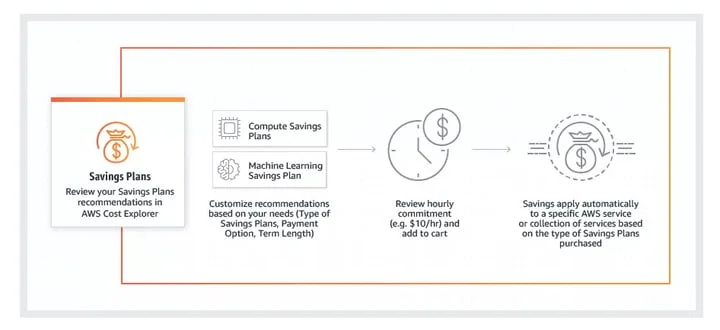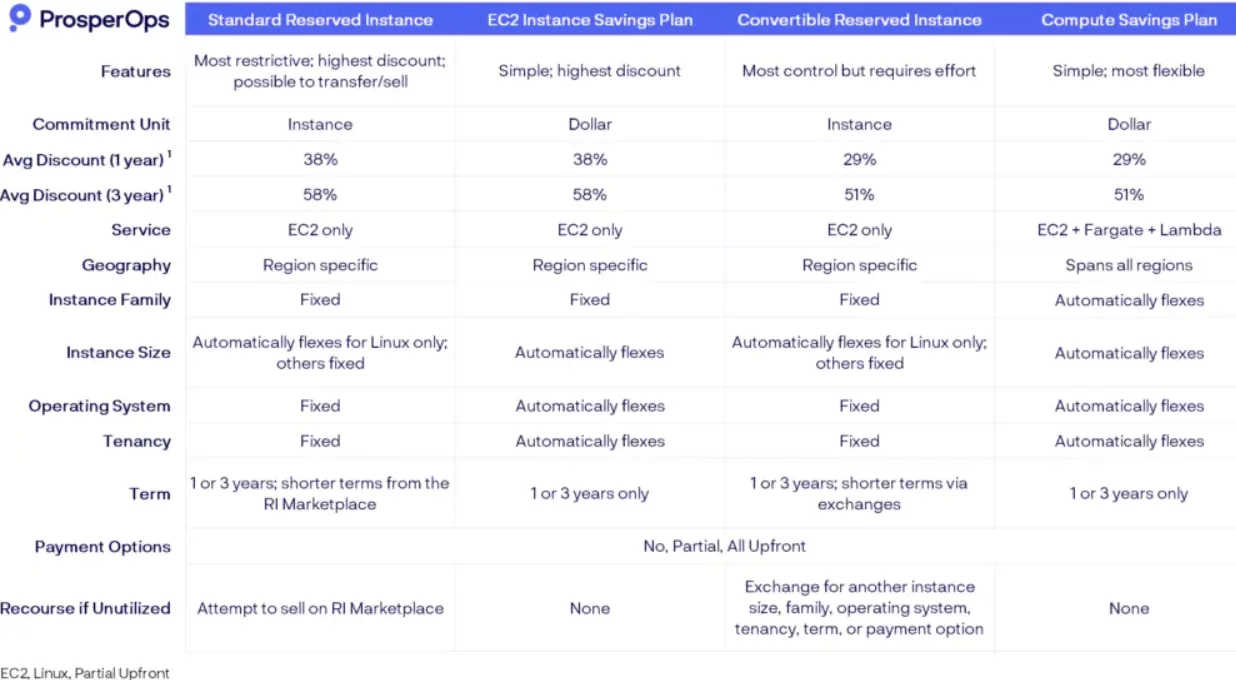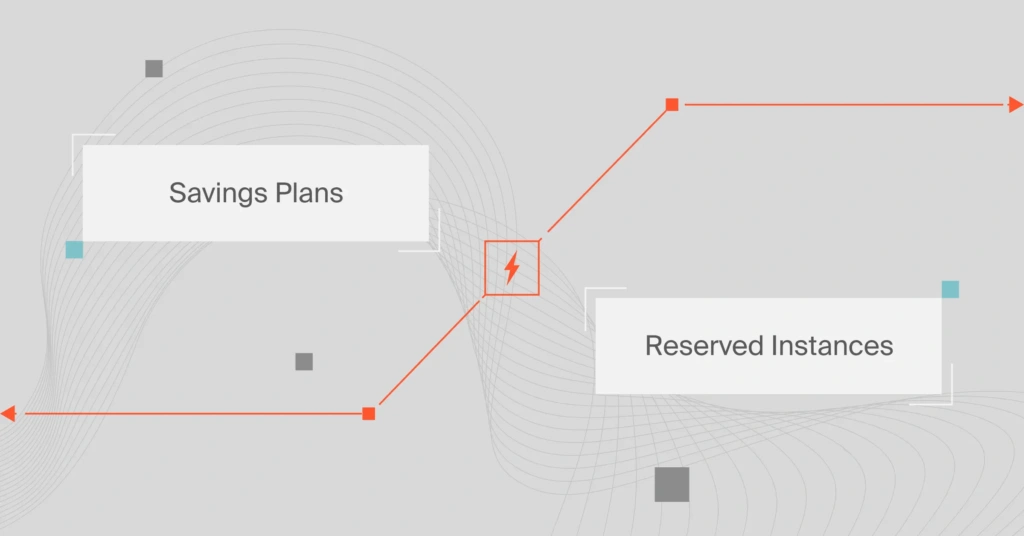A decade after launching Reserved Instances (RIs), Amazon Web Services (AWS) introduced Savings Plans as a more flexible alternative to RIs. AWS Savings Plans are not meant to replace Reserved Instances; they are complementary.
SPs and RIs have some significant differences that make each better suited to specific uses. For example, while Savings Plans apply to both EC2 and Fargate instances, RIs only apply to EC2 instances.
Let’s break down AWS Savings Plans vs. Reserved Instances in greater detail and explore how cost allocation can fill the gap left by these models.
What Are AWS Savings Plans?
With AWS Savings Plans, you do not purchase actual instances but commit to one or three years of On-Demand Instances at a discounted price. This discount can amount to 72% off the regular On-Demand price.
Here’s a screenshot from AWS illustrating how Savings Plans work:

AWS offers three types of Savings Plans: EC2 Instance Savings Plans, Compute Savings Plans, and Amazon SageMaker Savings Plans. Each plan applies to the kind of usage it’s named for. For example, Compute Savings Plans apply to AWS Lambda, Amazon EC2, and AWS Fargate usage.
Our AWS Savings Plans guide explains how these plans work and their pros and cons. We also covered how Queuing AWS Savings Plans works.
What Are AWS Reserved Instances?
AWS Reserved Instances (RIs) is a discount pricing model that enables organizations to save up to 75% on On-Demand Instances when they purchase them in advance for a fixed term of one or three years.
RIs enable you to “book” a certain amount of computing power and pay in advance. The three payment options are:
- All Up-front Reserved Instances (AURI)
- Partial Up-front Reserved Instances (PURI)
- No Up-front Reserved Instances (NURI)
We have also covered AWS Reserved Instances, the differences between On-Demand and Reserved Instances, and the pros and cons of Reserved Instances in this AWS RI guide.
Standard Vs. Convertible Reserved Instances
Standard RIs offer up to 75% savings compared to On-Demand pricing and are ideal for predictable, steady-state usage where the instance type, region, and operating system remain consistent over the reservation term.
After purchase, you will not be able to modify the instance class or operating system, so be sure these are factors your organization is committed to.
Convertible RIs provide greater flexibility, allowing changes to instance families, operating systems, and tenancies during the reservation period. This flexibility comes with a slightly lower discount, generally around 54% off On-Demand rates.
This makes convertible reserved instances best used for less predictable workload environments, but ones where you can still capitalize on long-term discounts.
Regional Vs. Zonal Reserved Instances
Reserved Instances can be categorized in either a zonal or regional bucket. As far as Regional RIs, these instances can be applied to an entire AWS region within the same family. This is independent of the region size.
Zonal RIs have a smaller scope. They only apply to a particular Availability Zone, and the reserved capacity is specific to that zone. Regional RIs have a bit more coverage.
So, are Reserved Instances and Savings Plans the same?
AWS Savings Plans Vs. Reserved Instances: An Overview
AWS Savings Plans (SPs) | AWS Reserved Instances (RIs) | |
Description | Save up to 72% on Amazon EC2 usage by committing to use a set level of compute power in $/hour for 1 or 3 years. | Save up to 72% on Amazon EC2 usage by committing to use a set level of compute power in $/hour for 1 or 3 years in a specific AWS Region and instance family. |
Types | Compute Savings Plans EC2 Instance Savings Plans Queued Savings Plans | Convertible Reserved Instances Standard Reserved Instances Scheduled Reserved Instances |
Potential savings | Up to 66% for Compute SPs and up to 72% for EC2 Instances SPs. Specifically, 40% off for 1 year; 60% off for 3 years | Up to 66% for Convertible RIs and up to 72% for Standard RIs. Specifically, 31% off for 1 year; 54% off for 3 years. |
Usage applies to | Amazon EC2 instances (Compute SPs apply regardless of instance family, operating system, AWS Region, instance size, or tenancy. EC2 Instance SPs apply to a specific AWS Region and instance family. AWS Fargate AWS Lambda Amazon SageMaker | Amazon EC2 instances (must match the instances you currently use to work) |
Capacity reservation | Not by default. But you can reserve capacity through On-Demand Capacity Reservations. | Yes, by default for usage within a specific Availability Zone. Convertible RIs can be exchanged or modified. Standard RIs can be modified but not exchanged. |
Ideal use case | Usage is mostly steady and may require changes to instances from time to time. | Steady and predictable usage with the same instances. |
Savings Plans Vs. Reserved Instances: Similarities
RIs and Savings Plans both offer a similar commitment period and payment options. Some similarities include:
- AWS bills both models by the hour.
- RIs and Savings Plans are available in three payment options: all up-front, partial up-front, and no up-front.
- Convertible Reserved Instances and Compute Savings Plans offer similar savings. Standard RIs provide similar discounts to EC2 Instance Saving Plans.
- Amazon applies its regular On-Demand pricing when you exceed your usage commitment during your contract period.
Still, each billing model is unique. It’s also not possible to change to the other billing model mid-contract. So, which one do you pick?
Here are some differences between both options, so you can decide which one best suits your organization.
Key Differences Between AWS Savings Plans Vs. Reserved Instances
Savings Plans and Reserved Instances differ in flexibility, where to buy, the amount of savings for specific AWS services, and where you can apply each model’s discount.
To begin with, Reserved Instances are based on the commitment to use an instance at a particular price over a specific period, while Savings Plans are based on the commitment to spend a particular dollar amount per hour over a specific period.
ProsperOps, one of our partners and a service that programmatically optimizes your AWS compute RIs and Savings Plans, created the following image to help explain some quick, key differences between Reserved Instances and Savings Plans.

Credit: ProsperOps
The following are the differences between Reserved Instances and AWS Savings Plans.
Flexibility
Compute Savings Plans offer multiple locations/regions and usage types, while Convertible Reserved Instances are assigned to a specific location/region, instance type, operating system, and tenant. You cannot change these once you’ve purchased RIs.
When your computing needs change, you can repurpose your Compute Savings Plans or transfer workloads across instance types regardless of operating system or tenancy. In comparison, you could use Standard Reserved Instances with various instance types. But you’d need to have a Linux OS and Default Tenancy.
You can also queue AWS Savings Plans to apply automatically at a future date rather than immediately. You can avoid using more expensive On-Demand instances by scheduling Savings Plans to deploy before or after your existing subscription expires.
Application scope
Reserved Instances apply across Amazon EC2, Elasticsearch, Relational Database Service (RDS), and RedShift; Compute Savings Plans support Amazon EC2, AWS Fargate, and AWS Lambda. Savings Plans do not cover Amazon RDS, just as RIs do not cover Fargate for serverless applications.
Automated coverage
Savings Plans continue to apply in case of changes in your instances or infrastructure, but RIs have to be monitored continuously to ensure they are applied.
As a result, Savings Plans may offer lower management overhead than RIs.
Resell or exchange
You can resell surplus RIs or purchase additional Standard RIs from the AWS Reserved Marketplace. AWS keeps a 12% service fee.
You can also exchange your Convertible RIs to enhance your commitment without resetting your contract. AWS Marketplace does not allow you to sell or buy Savings Plans.
Potential savings amount
Reserved Instances offer higher discounts, especially over three years. The key to capturing these savings is to ensure they are not underutilized or over-provisioned. More on this later.
In the meantime, when should you use Savings Plans vs. Reserved Instances or vice versa?
When Is It Best To Use AWS Savings Plans?
Savings Plans offer flexibility, making them ideal for organizations and systems prone to usage changes. They are ideal when you:
- Want to save on compute services, not on database usage.
- Expect that your usage requirements will fluctuate significantly during the contract period. Compute Savings Plans allow exchanges between instance families, operating systems, sizes, tenancies, and regions. Yet, Savings Plans aren’t as suitable for short-term usage as, for example, Spot Instances. Short-term here means: dev, build, testing, etc.
- You need a setup that automatically adapts to changes in your infrastructure without constant, manual monitoring.
- Are looking for discounts for serverless use cases with AWS Fargate and SageMaker applications.
- Your Amazon EC2, Fargate, and Labda usage fluctuate over short periods, such as from season to season.
When Is It Best To Use AWS Reserved Instances?
Reservations are non-cancelable. So, make sure you purchase RIs when you:
- Plan to use them throughout the contract period, or at least 75% of the time.
- Use applications that require constant, “always-on” power for the better part of one to three years at a time.
- Need to extend discounted instances for databases (Amazon RDS) and compute (Amazon EC2) uses.
- You have a reasonably consistent usage pattern over an extended period.
Despite this, both AWS Savings Plans and Reserved Instances require meticulous planning. Over-provisioning or under-utilizing the instances can quickly result in lost potential savings.
Think Cloud Cost Intelligence Instead
You can use Auto Scaling, Spot Instances, and rightsize RIs or Savings Plans to match your computing needs. This also requires a great deal of planning and forecasting. But most companies cannot accurately predict future utilization because their usage patterns fluctuate.
Additionally, AWS Cost Explorer struggles to predict future usage beyond seven, 30, and 60 days.
And something else. Because Cost Explorer needs historical data to calculate and make reliable purchase recommendations, it cannot calculate or make accurate recommendations if your AWS Savings Plan expired recently.
However, manually selecting the most suitable AWS instances for your needs can be time-consuming. For example, there are more than 400 EC2 instances to choose from. In addition, most AWS cost management tools estimate your needs based on the instances you have now, not on what you will need in the future.
Most cost tools struggle to link the people, processes, and products that drive AWS usage and associated costs. This makes it challenging to pinpoint where you can make trade-offs or pull strings to reduce consumption and costs without sacrificing availability, performance, or engineering velocity.
It’s also difficult to predict usage over several months, let alone a year or three years down the road. So, what do you do?
Three things:
1. Choose an AWS Savings Plan based on your engineering needs.
2. Track your usage and costs for one to three months with CloudZero. With CloudZero, you can see precisely who or what is driving your AWS costs down to:
- Cost per customer/tenant
- Cost per product feature
- Cost per environment
- Cost per dev team
- Cost per deployment
- Cost per project, etc.
3. This cost granularity can help you identify which areas to prioritize and which to trade off to lower your bill without compromising service quality.
 to see how CloudZero can help you forecast and allocate AWS costs, including cost anomaly detection.
to see how CloudZero can help you forecast and allocate AWS costs, including cost anomaly detection.
- You can then use ProsperOps for both RIs and Savings Plans benefits. Using real-time automation, ProsperOps programmatically blends Savings Plans and Convertible RIs to extend your multi-region, Lambda, and Fargate coverage (AWS Savings Plans) with additional term control and database coverage (Reserved Instances).
- If you use Spot Instances for short-term workloads, you can automate switching to them when the price is right with Xosphere. Xosphere automatically switches your system back to On-Demand Instances once Spot Instances become uneconomical, in time to prevent performance issues or cost surprises.
Frequently Asked Questions About AWS Savings Plans Vs. Reserved Instances
What is the difference between EC2 Savings Plan and Reserved Instances (RIs)?
Reserved instances provide a discount when you reserve a certain amount of computing power (measured per hour) for a one- or three-year period, while Savings Plans provide a discount when you commit to spending a certain amount (measured in dollars per hour) for a one- or three-year period.
What are the three types of Savings Plans AWS offers?
AWS offers Compute Savings Plans, EC2 Instance Savings Plans, and SageMaker Savings Plans.
Can both Savings Plans and Reserved Instances apply to the same usage?
AWS applies RIs to your eligible usage before Savings plans. Also, ECS Instance Savings plans apply before Compute Savings plans, which have a broader application scope.
Do AWS Savings Plans and reservations cover Spot instances?
No. The price for Spot instances is already up to 90% discounted, so any other form of discount will not apply.
What is the advantage of choosing reserved instances over savings plans?
With AWS RIs, you secure a fixed capacity in a particular Availability Zone, so you can launch workloads whenever you want. With Convertible RIs, you get more flexibility to change instance families, operating systems, and tenancies over the course of the contract without sacrificing the 72% savings of RIs.
What is the advantage of choosing savings plans over RIs in AWS?
Savings plans offer more flexibility over AWS reservations. For example, SPs apply across instance families and generations as well as AWS Regions.
Can you schedule reserved instances?
Yes. With this option, you can align your capacity reservation to a predictable time when your business will need it. If you specify it, this time can be recurring and can vary from a couple of hours a day to a month.








